BAVARIA
Religion

Religion
Cities in BAVARIA
| Munich |
Popular destinations GERMANY
| Bavaria |
Religion
General
Bavaria is with approx. 52%, after Saarland (approx. 61%), the German state with the most Roman Catholics in the population. By far the most Catholics live in the most southern part of Bavaria. Furthermore, about 20% of the population is Evangelical Lutheran, but these proportions do not apply to all 'Bezirken'. The Upper Palatinate, Lower Bavaria and Upper Bavaria, together called Altbayern, and Lower Franconia are predominantly Catholics, Middle Franconia and parts of Upper Franconia are mainly Protestants.
The Catholic parishes belong to the Diocese of Würzburg and the Diocese of Eichstätt in the Archdiocese of Bamberg; the dioceses of Passau, Regensburg and Augsburg belong to the Archdiocese of Munich und Freising. The Evangelical Lutheran Church in Bavaria is part of the Evangelische Kirche Deutschland and is divided into the circles Ansbach-Würzburg, Augsburg, Bayreuth, Munich, Nürnberg and Regensburg Image: overview of the two largest Christian confessions, the Roman Catholic Church (blue) and Evangelical Church (red) in the federal states of Germany.
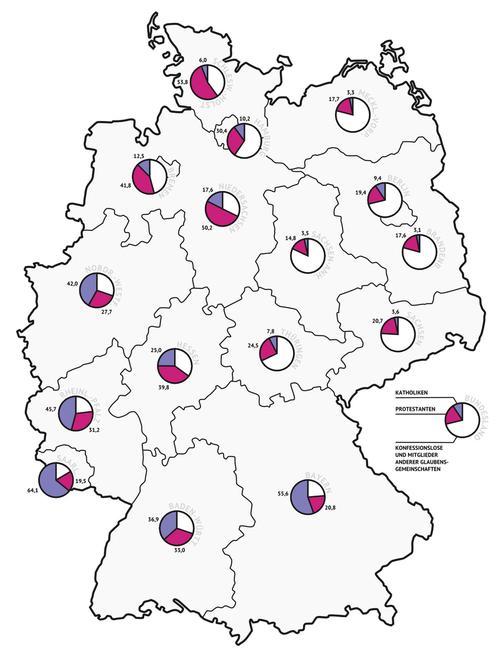 Distribution of the two largest confessions in GermanyPhoto: KaterBegemot CC 3.0 Unported no changes made
Distribution of the two largest confessions in GermanyPhoto: KaterBegemot CC 3.0 Unported no changes made
Until the 19th century, Jewish communities were mainly found in the rural areas of Bavaria and in cities like Nürnberg and Regensburg. There were hardly any Jews living in Altbayern, later in the 20th century there were more and more. Of the nearly 200 pre-Holocaust Jewish congregations in Bavaria, only thirteen are left.
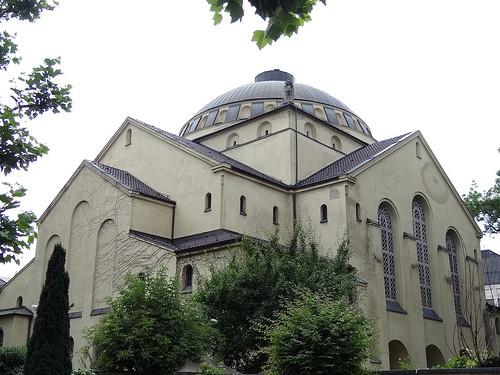 Jewish synagogue in Augsburg, BavariaPhoto: Adam Jones CC 3.0 Unported no changes made
Jewish synagogue in Augsburg, BavariaPhoto: Adam Jones CC 3.0 Unported no changes made
A special (Maria) pilgrimage site is Altötting in Oberbayern. Many pilgrims come to see a 14th century wooden statue of a black Madonna in the Gnadenkapelle. In the 15th century, some miracles were attributed to the statue, dead people are said to have been brought back to life. The Gnadenkapelle dates from the 8th century and other churches in Altötting are the Stiftspfarrkirche St. Philipp und St. Jakob, the St. Magdalena-Kirche and the large Basilika St. Anna (neo-baroque church from 1912 with 8000 seats).
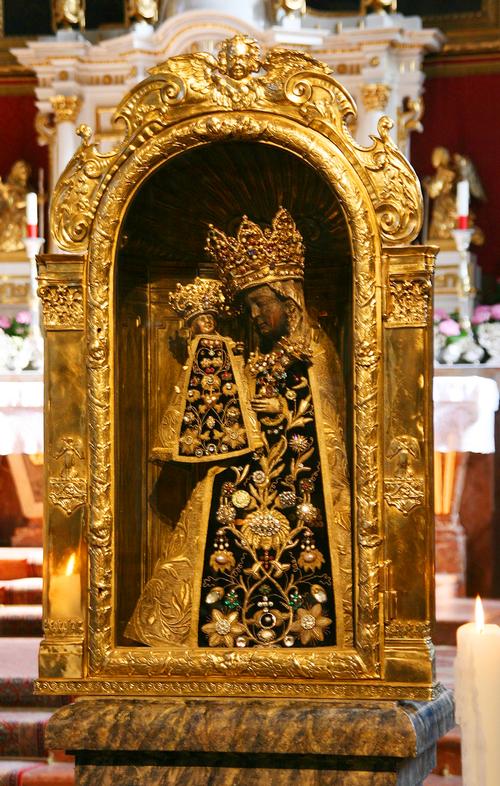 Black Madonna in the Gnadenkapelle of Altötting, BavariaPhoto: S. Finner CC 3.0 Unported no changes made
Black Madonna in the Gnadenkapelle of Altötting, BavariaPhoto: S. Finner CC 3.0 Unported no changes made
Benedictine Monastic Order in Bavaria
Bavaria has a large number of Benedictine monastery complexes and the Benedictine Order has played a major role in the cultural and artistic field in this German state. Born in Italy, Saint Benedict of Nursia (480-547) is generally considered the father of monastic life in the Latin Church and the founder of the Benedictine Order, the oldest order of the Catholic Church, founded at the beginning of the 6th century. Monks were required to take the three vows of poverty, chastity and obedience and devote themselves only to prayer and work, 'ora et labora'.
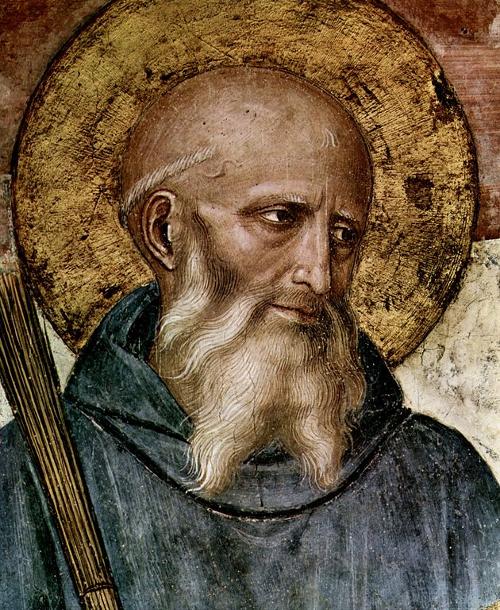 Benedict of Nursia is often found in religious buildings in BavariaPhoto: Public domain
Benedict of Nursia is often found in religious buildings in BavariaPhoto: Public domain
With the large amount of money that the order owned, churches and monasteries (abbeys) were beautifully decorated and made of the most expensive materials. In these buildings you will often also find paintings and altarpieces depicting Benedict. During the Enlightenment, the question was raised in Europe about the usefulness and meaning of monasteries. In Germany this led to the abolition of almost all monasteries (Reichsdeputationshauptschluss), which now became the property of landowners. This crisis in the monasticism came to an end in Romanticism, because in that period the Catholic orders were again appreciated and flourished again.
In 1830, the Bavarian Benedictine Abbey of Metten was again inhabited by Benedictine monks. Even at the time of the 'Kulturkampf' at the end of the 19th century and under the Nazi regime, the monasteries and monks had a difficult time. At the moment there are about fifty Benedictine monasteries for men or women in Germany. Since 1893, all Benedictine monasteries have been united in the Benedictine Confederation. Benedictine monasteries can still be found in Bavaria in Augsburg, Metten, Munich, Niederaltaich, Ottobeuren, Plankstetten, Rohr, Schäftlern, Scheyern, Wechselburg and Weltenburg, all of which are members of the 'Bavarian Benedictine Congregation', an association founded in 1684 by Pope Innocent XI was founded.
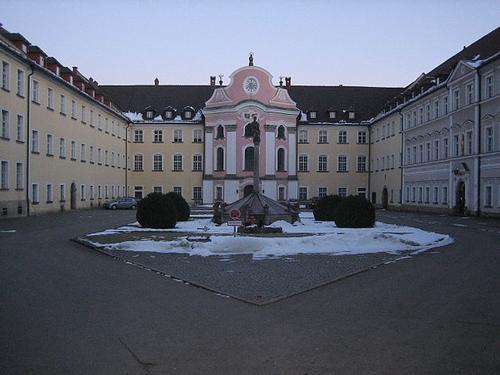 Benedictine Monastery Saint Archangel Michael in Metten, BavariaPhoto: Andy king50 in the public domain
Benedictine Monastery Saint Archangel Michael in Metten, BavariaPhoto: Andy king50 in the public domain
Special religious buildings in Bavaria
ALTENSTADT
St. Michael-Kirche: Main Romanesque church in Oberbayern, built between 1180 and 1200. This three-aisled tuff basilica has a precious Romanesque crucifix, called 'Grosse Gott von Altenstadt'. The frescoes in the choir and the Romanesque baptismal font are from the 14th century.
AMBERG
-Maria Hilf: Baroque pilgrimage church, designed by the German builder and architect Johann Dientzenhofer (1663-1726) and built between 1696 and 1702. The ceiling paintings were made in 1718 by the late Baroque painter and architect Cosmas Damian Asam (1686-1739) . The gigantic altar is a creation of the Italian plasterer and sculptor Giovanni Battista Carlone (c. 1641 - c. 1720).
AUGSBURG
-St. Ulrich- und St. Afra-Kirche: Benedictine monastery church, built between 1447 and 1500, but radically renovated several times afterwards. The terracotta statues of saints and the funerary monuments for the saints Ulrich and Afra are special. The carvings of the altars are by Johannes Degler from Weilheim (Oberbayern).
-Domkirche St. Maria: oldest church in the diocese of Augsburg, built and renovated in the period 10th-15th century. Stained-glass windows with depictions of the prophets and Mary from 1130, making them the oldest in Germany. Noteworthy are four altar paintings by the German painter Hans Holbein the Elder (c. 1460-1524) from the late 15th century and a stone 'Löwenthron' from 1100, on which the Augsburg bishops sat. The crypt dates from the 10th century.
-Heilig-Kreuz-Kirchen: two churches, one Catholic (16th-18th century), the other Protestant (built around 1650 and expanded in 1735) with works by the German Baroque painter Johann Heinrich Schönfeld (1609-1684).
-St. Annakirche: 14th / 15th century church with a tower from 1602 and converted in the Baroque style in 1748. Contains two special chapels: Fuggerkapelle, generally regarded as the first renaissance building in Germany, and the Goldschmiedekapelle from the period 1420-1425 with beautiful 15th / 16th century murals. The ceiling fresco of the St. Annakirche is by the German Baroque painter Johann Georg Bergmüller (1688-1772).
BAMBERG
-Bamberger Dom (officially: Bamberger Dom St. Peter and St. Georg): three-aisled basilica from the 13th century with four late Romanesque and early French Gothic towers, decorated with many windows and Gothic carvings. A special feature is the marble tomb of Pope Clement II, the only Pope buried north of the Alps. The main attraction of the church is the statue from around 1230 of the knight king called 'Bamberger Reiter'. No one knows who made the image and which king it represents.
BUXHEIM
-Kloster Buxheim: beautiful and extremely well preserved Carthusian monastery from 1402. Built according to a well-defined Carthusian scheme. Abandoned by the Carthusians in 1803 and later taken into use by Don Bosco Salesians.
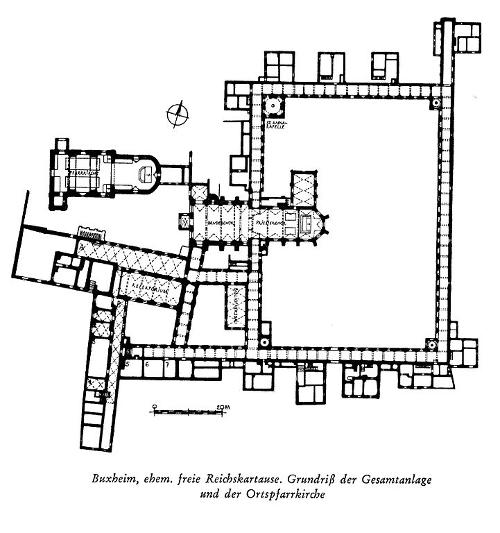 Floor plan Carthusian monastery in Buxheim, BavariaPhoto: Public domain
Floor plan Carthusian monastery in Buxheim, BavariaPhoto: Public domain
CHAM
-St. Jakobskirche: dedicated to Saint James of Compostela, patron saint of pilgrims. Nave is from the 12th century, choir at the end of the 13th century and baroque interior is from the 18th century. The 18th century ceiling paintings are by Johann Gebhard (1676-1756) and his son Otto Gebhard (1703-1777).
FÜRSTENFELDBRUCK
Klosterkirche Mariä Himmelfahrt: one of the most beautiful and largest (83 m long x 27 m wide x 28.4 m high) churches in Oberbayern, built to a design from 1700 by Giovanni Antonio Viscardi (1645- Munich 1713) and consecrated in 1741. Built in rococo style and with Italian, French and Bavarian style features by artists and architects such as the Italian Francesco Appiani (1704-1792), the German brothers Cosmas Damian Asam (1686-1739) and Egid Quirin Asam (1692-1750), the Beier Tassilo Zöpf (1723-1807), RA Boos and the German rococo painter Franz Xaver Schmädl (1705-1777).
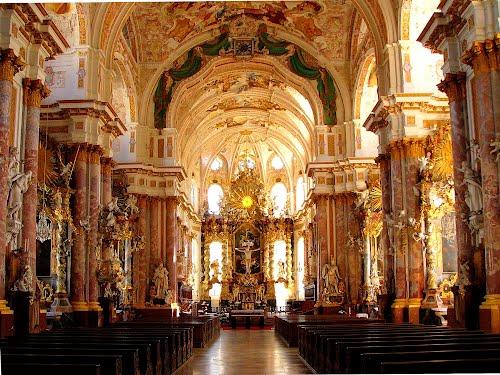 Interior Klosterkirche Mariä Himmelfahrt, Fürstenfeldbruck, BavariaPhoto: Gliwi CC 3.0 Unported no changes made
Interior Klosterkirche Mariä Himmelfahrt, Fürstenfeldbruck, BavariaPhoto: Gliwi CC 3.0 Unported no changes made
INGOLSTADT
-Liebfrauenmünster: Late Gothic large church with two towers from the 15th and 16th centuries. Due to a lack of money, construction took almost a century. The main altar dates from 1572 and paintings in the church are by the German painter and draftsman Hans Mielich (1516-1573) from Munich.
KEMPTEN
-St. Lorenz-Basilika: Catholic parish church built between 1652 and 1666 and designed by the Austrian architect Michael Beer (c. 1605 - c. 1666) and the Swiss architect Johann Serro (c. 1600 - c. 1660). Beautiful frescoes and choir stalls from 1669.
-St. Mang-Kirche: church built between 1426 and 1440 with a tower of 66 meters. Beautiful 17th century pulpit and frescoes, beautiful altar with carvings from 1893.
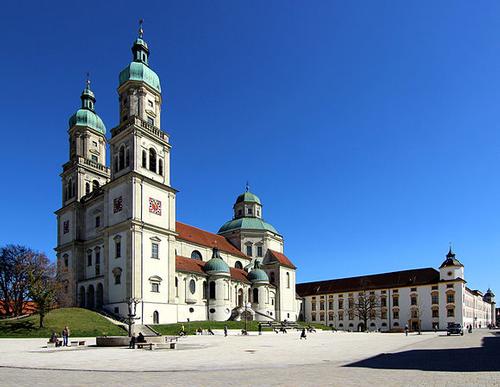 St. Lorenz-Basilika, Kempten, BavariaPhoto: Hilarmont CC 3.0 Deutschland“ no changes made
St. Lorenz-Basilika, Kempten, BavariaPhoto: Hilarmont CC 3.0 Deutschland“ no changes made
LANDSHUT
-St. Martinskirche: 15th century hall church with a nearly 131 meter high tower, the tallest brick church tower in the world; construction took 55 years. Sandstone altar from 1422 and oak choir stalls from the late 15th century and probably made by André Taubenbeck from Landshut himself. A special feature is the painted wooden statue of the Rosenkranzmadonna, made by Hans Leinberger (ca.1477 - ca.1531), one of the most important sculptors and woodcarvers of his time.
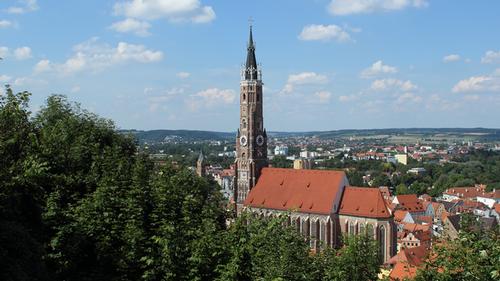 Landshut's St. Martinskirche stands out above everything elsePhoto: Andiamfeelinggood CC 3.0 Unported no changes made
Landshut's St. Martinskirche stands out above everything elsePhoto: Andiamfeelinggood CC 3.0 Unported no changes made
-St. Peterskirche: Munich's oldest church from the first half of the 11th century, even before the founding of the city. Very badly damaged in the Second World War, but restored and put back into service in 1954. The seated statue of Peter was made by the German sculptor, woodcarver and master builder Erasmus Grasser (ca.1450 - 1518) from the early 15th century. There are also choir stalls from 1750 and 167 and five wall panels from 1517. The 90 meter high tower is called 'Alten Peter'.
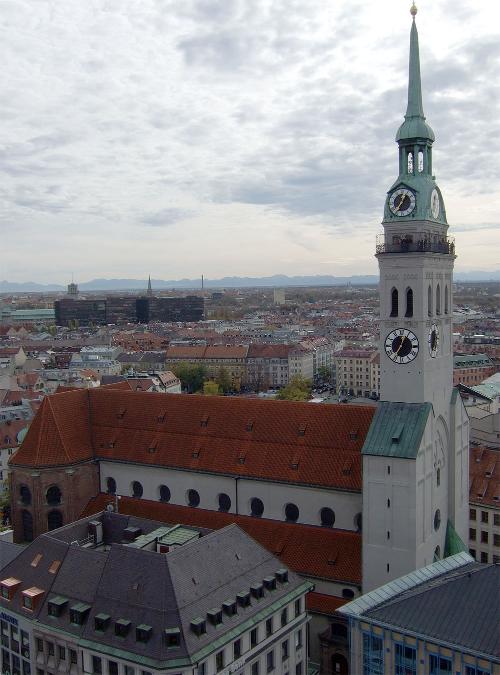 St. Peterskirche, Munich, BavariaPhoto: Public domain
St. Peterskirche, Munich, BavariaPhoto: Public domain
-Heilig-Geist-Kirche: This three-aisled hall church is located opposite the St. Peterskirche and is part of the Heilig-Geist-Spital from the 13th century. In the 18th century, the interior of the church was changed into Baroque and Rococo style by the brothers Cosmas Damian (1686-1739) and Egid Quirin Asam (1692-1750). This church was also badly damaged in the Second World War and many works of art were lost.
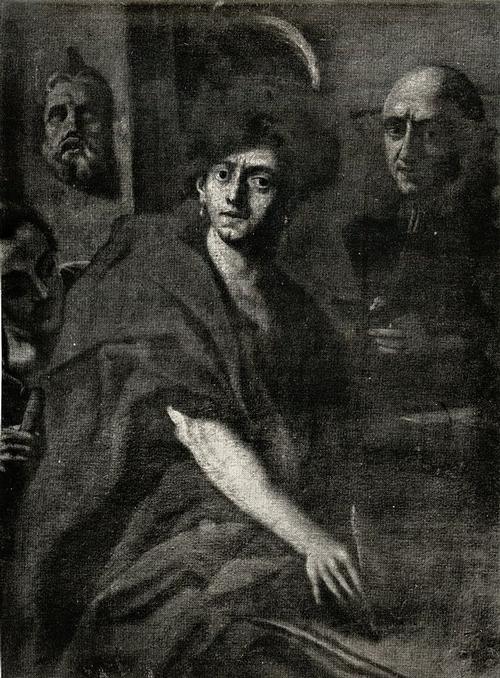 Portrait of Cosmas Damian Asam, made by his brother Egid Quirin AsamPhoto: Public domain
Portrait of Cosmas Damian Asam, made by his brother Egid Quirin AsamPhoto: Public domain
-Neue Münchner Hauptsynagoge Ohel Jakob: Synagogue opened in 2006, located next to the Jewish museum.
-Asamkirche (officially St. Johann-Nepomuk): beautiful but small late Baroque church (28 long x 9 meters wide), built and paid for in the 18th century (building, 1733; facade, 1746) by the Coasmas Damian brothers ( 1686-1739) and Egid Quirin Asam (1692-1750), sculptors, painters and architects working mainly in Southern Germany. Badly damaged in WWII, but completely restored and partially rebuilt. Architectural features, paintings and sculptures are typical of Baroque and Rococo. The highlight is the ceiling fresco of John of Nepomuk, the saint to whom the church is dedicated. The Asam brothers lived next door to the church and was their personal chapel for a while.
-Frauenkirche: late Gothic large bishop's church (100x40 meters, 2000 seats), with two identical towers, approx. 99 meters high, designed by Jörg von Halspach (ca.1441-1488), Münchner builder and architect, and built between 1468 and 1488 Contains a large grave monument for Emperor Ludwig IV der Baier, made by Hans Krumpper (ca.1570 - 1634). The spiritual heart of Munich and no other building in the center of Munich should be higher than this church. With a length of 109 meters, the largest hall church in southern Germany.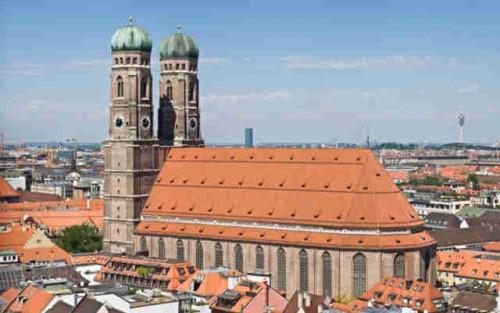 Frauenkirche, Munich, BavariaPhoto: Diliff CC 3.0 Unported no changes made
Frauenkirche, Munich, BavariaPhoto: Diliff CC 3.0 Unported no changes made
-St. Michael's Church: Renaissance Jesuit church (the first in Northern Europe) of St. Michael, built between 1583 and 1597 by order of Count Palatine Louis the Pious and designed by Wolfgang Miller, among others, who was inspired by the Roman church of Il Gesù. Forty members of the House of Wittelsbach, including Maximilian II and Ludwig II, are buried under the choir. Largest Renaissance church north of the Alps, with the largest barrel vault in the world after St. Peter's in Rome. Extensions to the church are attributed to the Dutch-German-Italian architect Frederik Sustris (ca.1540 - 1599).
-Bürgersaalkirche: contains an upper and lower church. Statues in the church were made by sculptor and representative of the Bavarian Rococo, Ignaz Günther (1725-1775) from the Oberpfalz. Landscape paintings of Bavarian pilgrimage sites along the walls of the church.
-Theatinerkirche or St. Cajetankirche (canonized Italian priest): Baroque mustard-colored church designed by the Italian architect Agostino Barelli (1627- c. 1687) and the Swiss architect Enrico Zuccalli (c. 1642-1724), in honor of the birth in 1662 of Maximilian II, Prince of Wittelsbach and Elector of the Holy Roman Empire. Ground plan in the shape of a Greek cross and characteristic is also the enormous 71 meter high dome.
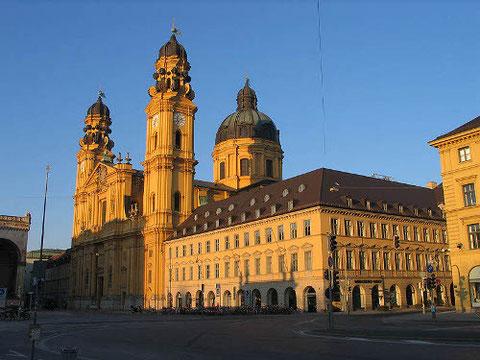 Theatinerkirche, Munich, BavariaPhoto: Luidger CC 3.0 Unported no changes
Theatinerkirche, Munich, BavariaPhoto: Luidger CC 3.0 Unported no changes
NÖRDLINGEN
-St. Georgskirche: 15th century late Gothic hall church, one of the largest in Germany with a tower of 90 meters and built by the late Gothic master builder Nikolaus Eseler the Elder (1410-1483). Beautiful interior with 15th century pulpit, choir stalls, organs and altars.
NÜRNBERG
-Frauenkirche: Bavaria's oldest Gothic hall church, built from 1350 to 1358 by the German-Czech architect Peter Parler (ca. 1330-1399) at the behest of Emperor Charles IV, on the foundations of a synagogue. Rebuilt after the Second World War, the stained glass windows and the Tucheraltar date from 1500 and c. 1550 respectively. A special feature is the sandstone 'Peringsdörfer' grave monument from 1498 and made by the late Gothic sculptor and master builder Adam Kraft (c. 1460 - 1509). Other churches worth visiting are: St. Sebalduskirche, St. Elisabethkirche, Egidienkirche, St. Klarakirche, St. Lorenzkirche and the 14th century hospital church St. Martha.
OBERAMMERGAU
-St. Peter und Paulkirche: beautiful Catholic parish church from the 18th century, built by the South German master builder Joseph Schmuzer (1683-1752), with a rococo interior. Special ceiling paintings by the important German painter Matthäus Günther (1705-1788). Oberammergau is also known for the Passion Plays that are held in a rhythm of ten years from 1680 (2020, 2030, 2040, etc ...). The first passion play dates back to 1634. Only villagers from Oberammergau are allowed to participate, and with about 2,400 inhabitants, more than half of the population actually participate. The theater has a capacity of 4800 visitors and spread over more than 110 performances, it attracts more than 500,000 visitors annually.
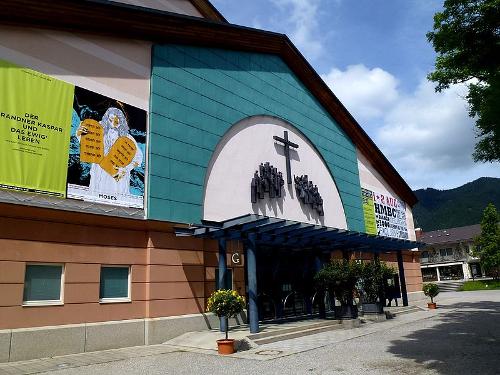 Passionsspielhaus from 1900 in Oberammergau where the passion plays are heldPhoto: Hiroki Ogawa CC 3.0 Unported no changes made
Passionsspielhaus from 1900 in Oberammergau where the passion plays are heldPhoto: Hiroki Ogawa CC 3.0 Unported no changes made
OTTOBEUREN
-Kloster Ottobeuren: originally from 764, but burned down several times in the 12th and 13th century. New construction dates from the 18th century and since 1918 the building has been used as a monastery again. Huge complex with two-towered Baroque basilica. This church was built by famous architects of the time: Carlo Andrea Maini (Switzerland, 1683 - ca.1731), Dominikus Zimmermann (Germany, 1685-1766), Johann Michael Fischer (Germany, 1692-1766) and for the interior especially Simpert Kraemer (Germany, 1679-1753). The rococo stucco is by Johann Michael Feuchtmayr the Younger (1709-1772) and the frescoes on the vaults are by the Austrian painter Johann Jakob Zeiller (1708-1783).
PASSAU
-St. St. Stephen's Cathedral: 101 meter long Gothic church, but with many Italian-Baroque influences in the interior. The facade of the church is by the Italian architect Carlo Lurago, the decorative stucco work by the Italian Giovanni Battista Carlone (1584-1631), the ceiling paintings by the influential Swiss-Italian Baroque painter Carpoforo Tencella (1623-1685), the paintings in the side aisles by the Swiss painter Carlo Antonio Bussi (1658-1690) and the main altar from 1953 was made by the German sculptor Josef Henselmann (1898-1987). The church houses five organs, which with 17,974 pipes make up the largest organ in Europe.
REGENSBURG
-Dom St. Peter: the most important Gothic cathedral in southern Germany. One of the towers, the 'Eselturm', dates back to Romanesque times. Construction of the brick cathedral began in the year 1250 and lasted until 1525. The main altar is early Classicist, the Gothic tabernacle dates from 1495. The western towers were not built until 1859-1869.
-Klosterkirche St. Emmeran: monastery church of the Benedictine monastery of St. Emmeran. The crypt is Romanesque, the portal is Gothic with arcades and wall paintings. The interior is baroque and is largely designed by the brothers Cosmas Damian (1686-1739) and Egid Quirin Asam (1692-1750), sculptors, decorative plasterers, painters, architects and important representatives of the German late Baroque.
ROSENHEIM
-St. Nikolauskirche: Late Gothic Catholic church with a yellow exterior, a remarkable tower and a rather sober interior. Reopened again in 2006 after a long renovation period. In 2009 the new organ was inaugurated, built by the Reil firm from Heerde in the Netherlands.
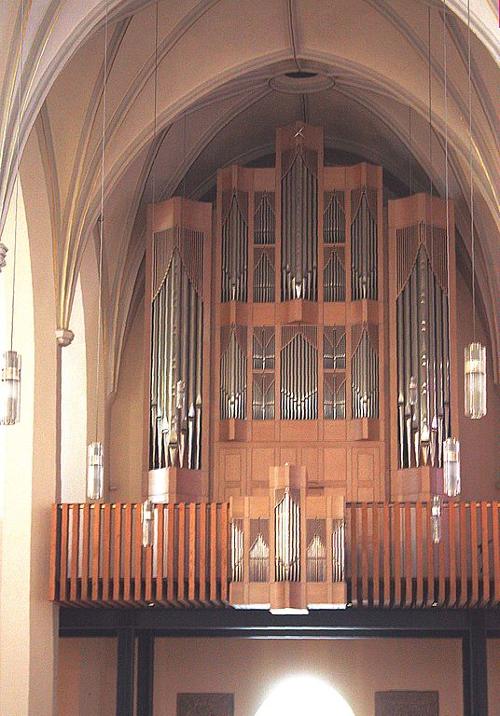 Dutch organ in the St. Nikolauskirche in Rosenheim, BavariaPhoto: Dguendel CC 3.0 Unported no changes made
Dutch organ in the St. Nikolauskirche in Rosenheim, BavariaPhoto: Dguendel CC 3.0 Unported no changes made
STEENADEN
-Wieskirche: this rococo pilgrimage church, built between 1743 and 1756, is the most important work of the brilliant master builder Dominikus Zimmermann (1685-1766) and his brother Johann Baptist Zimmermann (1680-1758), responsible for the decorative stucco and ceiling frescoes, and was placed on the World Heritage List by UNESCO in 1983. This fact and the fact that it is a pilgrimage church has ensured that approximately 1 million people visit the church every year. Basically everything about this church is beautiful, be it the altars, the pulpit, the statues or the organ. The statues of four evangelists were made by the Antwerp-born Ägidius Verhelst (1696-1749) and the statues of the four church fathers were made by the South German Baroque and Rococo sculptor Anton Sturm (1690-1757).
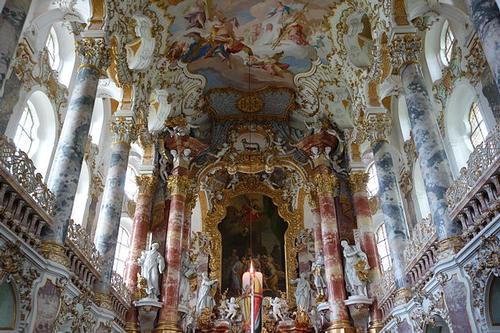 Johann Baptist Zimmermann designed the interior of the Wieskirche, Steingaden, BavariaPhoto: Danielloh79 CC 3.0 Germany no changes made
Johann Baptist Zimmermann designed the interior of the Wieskirche, Steingaden, BavariaPhoto: Danielloh79 CC 3.0 Germany no changes made
STRAUBING
-St. Peterskirche: Straubing's oldest church from the late 12th century. With some Romanesque remains, including a crucifix. The originally lavish baroque interior has disappeared over the centuries and the church therefore looks sober. The two 15th century statues of Saints Barbara and Catherine are special.
WÜRZBURG
-Domkirche St. Kilian: reconstruction of an earlier Romanesque church (1045-1188), named after the Christian martyr Kilian (ca. 640 - 689), an Irish missionary-bishop and apostle of Franks, northern Bavaria. Towers have both Romanesque and Gothic style features. Tomb containing Kilianus. One of the largest Romanesque churches in Germany.
-Neumünster: church with Baroque facade by the German Baroque builder and architect Johann Dientzenhofer (1663-1726). The church has a Romanesque back and was built on the tomb of St. Kilian and radically renovated in 1710. Behind the altar three statues of the Franks apostles St. Kilian, St. Kolonat and St. Totnan, but copies of the originals from 1608-1610 lost in the Second World War, made by the important late Gothic / early Renaissance master sculptor and -woodcarver Tilman Riemenschneider (ca.1460 - 1531). The contemporary paintings by the German artist Thomas Lange (1957 -....) above the arches of the nave are special.
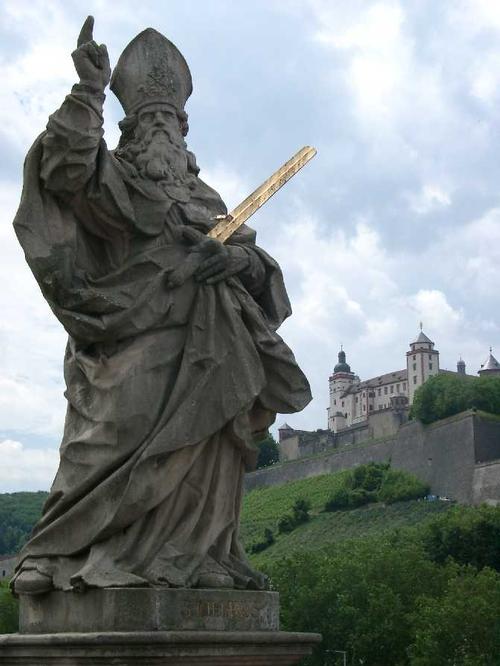 Statue of Saint Kilian on a bridge in Würzburg, BavariaPhoto: Lutz.marten at the engklish language wikipedia CC 3.0 no changes made
Statue of Saint Kilian on a bridge in Würzburg, BavariaPhoto: Lutz.marten at the engklish language wikipedia CC 3.0 no changes made
Sources
BBC - Country Profiles
CIA - World Factbook
Di Duca, Marc / Munich, Bavaria & the Black Forest
Lonely Planet
Egert-Romanowska, Joanna / Duitsland
Van Reemst
Meyer, Marion / Beieren
ANWB
Oberbayern : bayerisches Alpenvorland
Baedeker
Wikipedia
Copyright: Team The World of Info